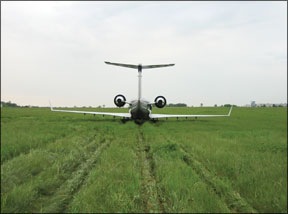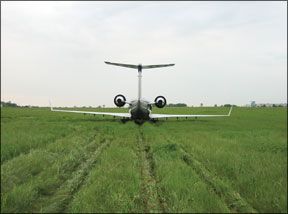It was a trip in its conceptual stages from the time I began taking flight lessons: Winchester, Va., to the lowlands of Lawrenceville, Va., where my grandparents reside. Almost four months after obtaining my private pilot certificate-upgrading from a recreational-I had the chance to make the journey. My wife and I, plus our two children, would fly down the upcoming Saturday for the weekend. 288 Due to a schedule conflict, I was unable to use my favorite aircraft. Instead, I settled for another 172, with which I was familiar but deeply loathed. It had a larger, 180-hp engine and a climb prop, and the combination made it hard to slow down. But the jubilation of finally embarking on a cross-country flight as a full-fledged private pilot presided over any ill feelings I had toward the aircraft. Toward the end of the 143-nm flight, we descended through a yawning hole in clouds to 2500 feet and I began scanning for the airport, finally spotting it just three miles ahead. I was close enough to enter the pattern on the crosswind leg. Tall pine trees and a power line preceded the threshold of Runway 36; there was no room for mistakes. Yet, as I turned final, I realized I was high and hot. Staying on the glidepath was easy but speed was still a factor. I leveled just above the runway to bleed off the excess speed until the aircraft gently touched down. Unfortunately, the runway slopes downward at a 1.7-percent gradient. Eventually, the airplane settled onto all its wheels, but we were better than halfway down the runway, headed downhill, and heavier than I had previously flown. The end of the runway seemed to be approaching more rapidly than it probably was. I applied brakes but they had little effect. Applying additional pressure resulted in the squeal of tires against pavement. The plane finally stopped just shy of the numbers. In retrospect, I made several mistakes. I allowed anxiety to cloud my judgment and thought processes, and failed to nail my landing speed. But there were two other factors contributing to nearly overrunning the runway. Poring over my charts and airport information before the flight, I never realized the downslope existed. The wind was calm, so I had the option of landing in either direction; landing uphill would have been preferred. Another factor in my blunder, and probably the most influential, is the illusion a sloped runway presents. For downhill slopes, the illusion is that the aircraft is on its glidepath when, in actuality, it is high. Proper and thorough planning is the key to a successful cross-country flight-even local flights. Mistakes can become common if we are sloppy or negligent in our responsibilities as pilots. – Jon E. Gaskins




